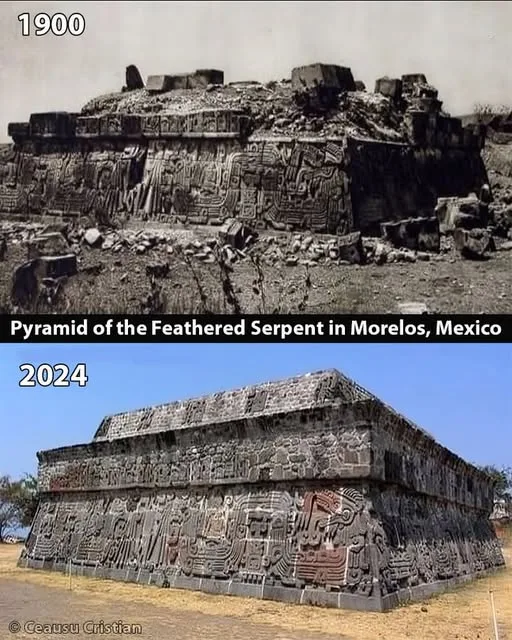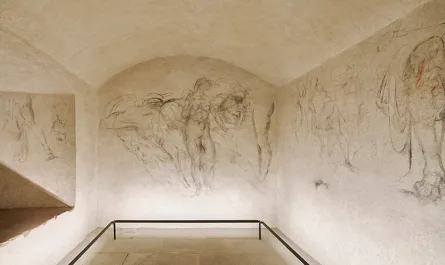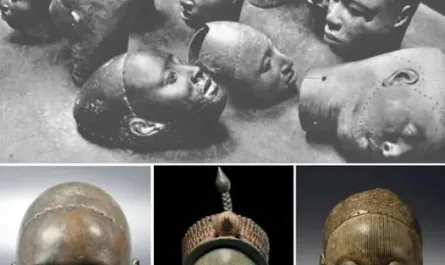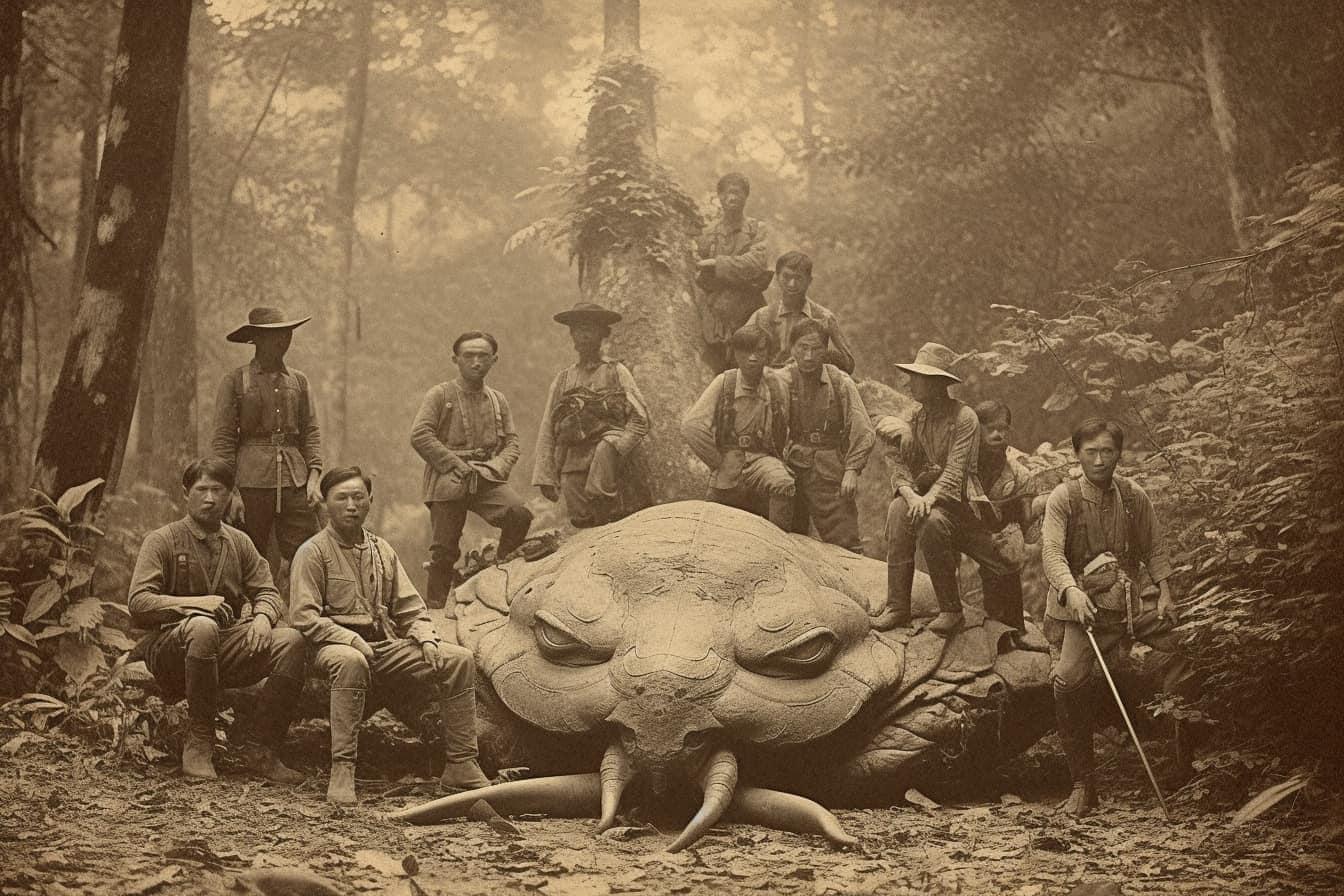Pyramid of the Feathered Serpent, Xochicalco: A Journey of Restoration and Revelation
The Pyramid of the Feathered Serpent at Xochicalco, located in Morelos, Mexico, stands as a striking testament to Mesoamerican ingenuity, its transformation from 1900 to 2024 reflecting a remarkable journey of restoration. Initially buried under soil and eroded by time, this pyramid—part of a thriving city between AD 700 and 900—has been meticulously uncovered, revealing intricate engravings that highlight its artistic and spiritual significance. As a cultural and astronomical hub, Xochicalco’s architecture, including this pyramid, offers profound insights into its civilization. Thanks to ongoing conservation efforts, visitors in July 2025 can marvel at its restored grandeur and explore the rich heritage of Mesoamerica.

Historical Context
Xochicalco, meaning “place of the house of flowers” in Nahuatl, emerged as a major center following the decline of Teotihuacan around AD 650. Flourishing from AD 700 to 900 during the Epiclassic period, it served as a melting pot of cultures, including Maya, Zapotec, and local groups, drawn by its strategic location and fertile lands. The Pyramid of the Feathered Serpent, a key structure within the site, was likely a temple dedicated to Quetzalcoatl, the feathered serpent deity symbolizing wisdom and creation. Its construction, using cut stone and adobe, reflects advanced engineering for the era, with the city supporting a population of 10,000–20,000 at its peak.
Abandoned around AD 900, possibly due to internal conflict or environmental changes, Xochicalco was gradually buried under vegetation and soil, remaining hidden until rediscovery in the early 20th century. Early explorations by Mexican archaeologist Leopoldo Batres in 1909 marked the beginning of its study, though significant restoration began later.
Transformation Through Restoration
From 1900 to 2024, the Pyramid of the Feathered Serpent underwent a dramatic metamorphosis:
- Initial State (1900): When first documented, the pyramid was partially buried, its upper tiers obscured by earth and its walls eroded. Early photographs show a mound with faint traces of stonework, hinting at its former glory.
- Excavation and Early Efforts: Between the 1940s and 1960s, the Instituto Nacional de Antropología e Historia (INAH) initiated excavations, uncovering the pyramid’s base and revealing initial carvings. However, limited technology and funding slowed progress.
- Major Restoration (1980s–2000s): With improved techniques, including laser scanning and soil stabilization, INAH restored the pyramid’s tiers, exposing its elaborate engravings. The process involved removing overburden, reinforcing the structure with concrete supports, and preserving fragile stonework.
- Recent Enhancements (2010–2024): By 2024, the pyramid’s facade, adorned with bas-reliefs of feathered serpents, warriors, and geometric patterns, was fully revealed. Conservation efforts focused on weatherproofing and installing walkways to protect the site while improving visitor access.
The pyramid, standing about 18 meters tall with a square base of 45 meters, now showcases its original stepped design and intricate carvings, restored to reflect its AD 700–900 appearance.
Architectural and Cultural Significance
The Pyramid of the Feathered Serpent is a highlight of Xochicalco’s architectural prowess:
- Engravings and Symbolism: The walls feature detailed bas-reliefs of Quetzalcoatl, interwoven with human figures and celestial motifs, suggesting a role in rituals or astronomical observations. The serpents, with open jaws and feathered crests, symbolize the deity’s dual nature as earth and sky.
- Astronomical Alignment: The pyramid aligns with the sun during equinoxes, and nearby structures like the Temple of the Sun reinforce Xochicalco’s reputation as an astronomical center. Carvings may have marked solstices or planting seasons.
- Construction Techniques: Built with limestone blocks and adobe, the pyramid’s stability on a hillside demonstrates advanced engineering, with drainage channels preventing erosion—a testament to the builders’ foresight.
Xochicalco’s role as a cultural crossroads is evident in its diverse influences, blending Maya stelae with local styles, making the pyramid a symbol of Mesoamerican unity and innovation.
Preservation and Visitor Experience
Designated a UNESCO World Heritage site in 1999, Xochicalco benefits from INAH’s ongoing conservation, addressing erosion from Morelos’ rainy season and tourist impact. The Pyramid of the Feathered Serpent is accessible via guided tours, with a 2024 upgrade adding shaded walkways and interpretive signs. Entry costs 85 MXN (about $4 USD), with free access on Sundays for Mexican nationals.
Visitors in July 2025 can climb the pyramid’s steps (with safety rails) and view the engravings up close, often enhanced by morning light. Posts on X praise its “hidden gem” status, with users noting the “serpent carvings come alive” and the site’s “peaceful vibe,” though some mention steep climbs as a challenge.
Challenges and Future Prospects
Preservation faces threats from humidity, seismic activity, and urban sprawl near Cuernavaca. INAH employs non-invasive techniques like 3D modeling to monitor structural integrity, but funding remains a hurdle. Future plans include expanding the visitor center with virtual reality exhibits to reduce physical wear and partnering with local communities to promote sustainable tourism.
Conclusion
The Pyramid of the Feathered Serpent at Xochicalco, transformed from a buried ruin in 1900 to a restored marvel by 2024, embodies the brilliance of Mesoamerica’s Epiclassic period. Its intricate engravings and astronomical alignments reflect a civilization that thrived from AD 700 to 900, offering insights into its art and spirituality.





